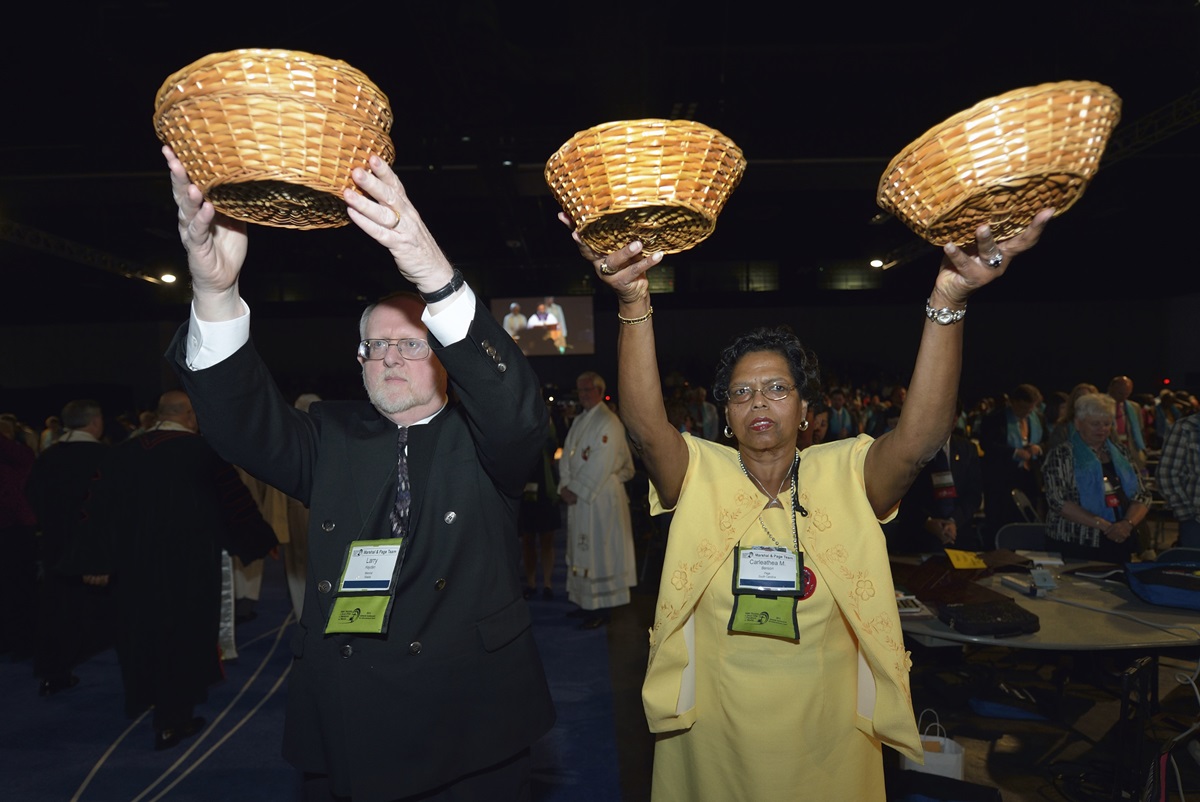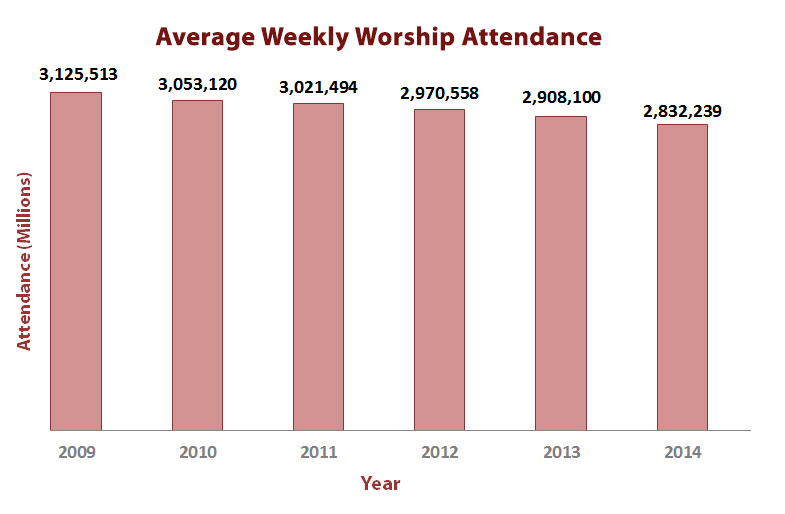A proposed modest increase to the general church budget is heading to the 2016 General Conference.
However, a number of United Methodists say that in the wake of the continuing decline in U.S. worship attendance the general church needs to tighten its belt.
The General Council on Finance and Administration board and Connectional Table each reaffirmed a projected budget of $611 million for general church funds in 2017-2020. Both bodies are responsible for developing the general church budget and both previously approved the same proposal during a joint meeting in May 2015.
“This budget reflects a hopeful, reasonable proposal of the resources needed to engage in the mission and ministries around the world,” Dakotas-Minnesota Area Bishop Bruce Ough, the Connectional Table chair, said in a statement.
“This budget reflects the faith we have in our leaders to continue the adaptive work in increasing vital congregations across our connection.”
The proposal represents about a 1.3 percent increase above the $603.1 million general church budget approved at the 2012 General Conference. The projected bottom line is still below previous general-church budgets approved in 2004 and 2008.
The four-year budget sets the apportionments that support bishops, United Methodist ministerial education and denomination-wide efforts such as the Black College Fund, ecumenical work and Africa University in Zimbabwe. The apportionments also fund 10 of the denomination’s 13 general agencies. That includes United Methodist Communications, which encompasses the United Methodist News Service.
The finance agency board on Feb. 19 supported the budget proposal by a vote of 14 to 3. The Connectional Table — which coordinates the denomination’s ministry and resources, including the work of agencies — supported the proposal during a Feb. 29 teleconference by a much narrower vote of 16 to 11 with one abstention.
The Connectional Table had to delay its vote by 10 days to get a quorum of its 47 voting members.
Members of both bodies warned against raising the budget when conferences and churches are dealing with fewer worshippers and at least some are considering slashing their own spending plans next year.
“We, too, are cutting our budget, even thinking about going down one more district superintendent,” said Chicago Area Bishop Sally Dyck during the Connectional Table teleconference. “I think it would be well received not to go to the higher number.”
The budget debate comes at a seeming paradoxical moment in the life of the church. Even as U.S. worship attendance slides down, overall giving has been going up.
“We have this kind of dichotomy that’s going on in many places where many conferences are struggling and yet our overall giving as a denomination continues to be strong for the time being,” Ough said during the teleconference.
Ultimately, General Conference, the denomination’s top lawmaking body, will determine the projected budget for the next four years when it meets on May 10-20 in Portland, Oregon.
Can Agencies Help?
The church’s general agencies receive the bulk of general church funds. So the question many United Methodist leaders ask: What are agencies doing to help reverse the decline in worship attendance?
The Connectional Table over the past four years has been exploring how it can better evaluate agencies in how they carry out the denomination’s mission and goals. That work is ongoing.
The Rev. Amy Valdez Barker, the Connectional Table’s top executive, said the leadership body’s first step has been to work with agency boards, which are the primary source accountability for each agency. The Connectional Table also has been looking at how agencies cooperate with conferences and local congregations.
“The greater step of the Connectional Table has been to see: How do all of these pieces work together?” she said.
Christine Dodson, a finance agency board member and the North Carolina Conference treasurer, said at General Conference she would like to see an honest discussion about why a budget increase is needed and what ministries the funds will support.
“The general agencies do much good work with what they are given and that ministry should be understood and celebrated,” she said. “I would like to see honest conversation about the ministries supported and the outcomes of those ministries in support of the mission of the church.”
Brewing budget debate
Members of the finance agency board and the Connectional Table have been working for nearly four years on the budget proposal that will go before General Conference.
Throughout much of the process, that budget work has had the broad support of both bodies. But that changed during the February meetings.
The reason is that the Economic Advisory Committee — a group of eight United Methodist economists and other financial professionals who advise the budget process — readjusted its forecast for the denomination downward.
The committee, which is independent of any church agency, bases its predictions around such variables as the U.S. gross domestic product, inflation and the Dow Jones Industrial Average, as well as United Methodist-specific data such as worship attendance. At this point, the U.S. church supports the bulk of general church finances.
The committee initially had recommended a budget of $628 million in 2014 and reduced that to $621 million in 2015. At its late January meeting, the committee reduced that recommendation dramatically, suggesting denominational leaders consider a budget of $595.6 million or an optimistic budget of $604 million.
Dyck and some other Connectional Table members urged the budget be set at the $604 million level.
The committee recommended the reduction after seeing U.S. average weekly worship attendance plummet by about 2.6 percent between 2013 and 2014. The drop of nearly 76,000 worshippers is the largest in the denomination’s records going back to 1977. The decline is also more precipitous than the committee predicted, according to its report.
Between 2002 and 2013, worship attendance dropped on average by about 52,000 a year.
“The annual rate of decline is getting larger, and there is little reason for optimism, absent the implementation of effective strategies designed to arrest the decline,” the committee’s report said.
Nevertheless, the budget leadership team — comprising members of both the finance agency board and Connectional Table — has stuck with the $611 million recommendation.
“We — the budget leadership team — feel very strongly that the previously approved level of $611 million falls within the reasonable range of probable outcomes,” Charlie Moore, a finance agency board member from the Baltimore-Washington Conference, said at the Feb. 19 meeting.
Donald R. House Sr., the Economic Advisory Committee chair and an economist, agreed that the proposed budget is still within range of his committee’s recommendations.
He told United Methodist News Service he does not consider the increase “such a shock that it will send tremors through the annual conferences.” But he does expect payout rates will go down.
PAid in Full
The following U.S. conferences paid full general church apportionments in 2015:
Alaska, Baltimore-Washington, California-Pacific, Central Texas, Dakotas, Desert Southwest, East Ohio, Eastern Pennsylvania, Greater New Jersey, Holston, Illinois Great Rivers, Iowa, Kentucky, New England, New York, North Carolina, Oklahoma Indian Missionary, Oregon-Idaho, Peninsula-Delaware, Red Bird Missionary, Rocky Mountain, Susquehanna, Tennessee, West Ohio, Western Pennsylvania and West Virginia.
Paradox of increased giving
That will be a change from current trends. As the U.S. economy has improved, the denomination has been experiencing banner years in giving.
At the same time as worship went down in 2014, giving went up by 2.38 percent ─ more than House’s committee predicted.
In 2015, 26 of the 56 U.S. conferences paid full apportionments to support the general church — the highest number in the 16 years that the church has digital records. Last year’s giving exceeds the previous record of 25 conferences set in 2014.
Put another way, United Methodists gave more than $130.6 million to general church funds, nearly 92 percent of the requested apportionments. That’s up from $130 million in 2014, a payout rate of nearly 91 percent.
House of the Economic Advisory Committee has an explanation for this seeming paradox.
“What we discovered is that we’re losing worship attendance through funerals,” he said. “We are bringing in new members. But the new members aren’t like the people we’re burying.”
The new members tend to be in higher-income suburbs and can afford to give more, while many of those who are dying tend to be lower-income rural areas. About 60 percent of the denomination’s roughly 32,000 U.S. churches are in rural areas.
“That’s why giving continues to grow despite the decline in worship attendance — it’s because of this turnover,” House said. However, the addition of new worshippers is not keeping pace with the losses.
“We have to ask ourselves: Is this a process that can continue forever? We’re not sure it can,” House said. “There will be a day when our giving will plateau.”
In at least some areas, that already may be happening.
The Rev. Marc Brown, a Connectional Table member and the Virginia Conference’s director of connectional ministries, said his conference is expecting to cut its budget by $267,000 in 2017. At the same time, if General Conference approves the proposed budget, his conference's general-church apportionments will increase by $96,100.
Bill Brownson, treasurer and director of administration for the West Ohio Conference, is this year’s president of the National Association of Annual Conference Treasurers. He has heard from about 20 conference treasurers, and most will have little or no increase from their 2015 or 2016 budgets.
“For conferences committed to paying 100 percent of general church apportionments and also committed to keeping their overall apportionments flat, the impact of increasing general church apportionments is a reduction in resources for conference ministries, both locally and globally,” Brownson told United Methodist News Service.
“This message is not an easy one for annual conferences to hear, especially if conference spending has already been significantly reduced.”
Hahn is a multimedia news reporter for United Methodist News Service. Contact her at (615) 742-5470 or newsdesk@umcom.org.
Like what you're reading? Support the ministry of UM News! Your support ensures the latest denominational news, dynamic stories and informative articles will continue to connect our global community. Make a tax-deductible donation at ResourceUMC.org/GiveUMCom.




